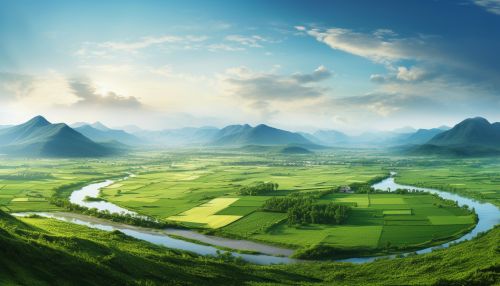Godavari
Geography
The Godavari is the second longest river in India, after the Ganges, and is often referred to as the 'Dakshina Ganga' or the 'Ganges of the South'. It originates near Trimbak in Nashik District of Maharashtra state and flows eastwards across the Deccan Plateau into the Bay of Bengal near Narasapuram in Andhra Pradesh, covering a distance of approximately 1,465 kilometers.


The river basin is considered to be the largest in peninsular India, covering parts of Maharashtra, Telangana, Andhra Pradesh, Chhattisgarh, Madhya Pradesh, Odisha, and Karnataka. The basin is bounded by the Western Ghats in the west and the Eastern Ghats in the east, which receive high rainfall during the monsoon season, feeding the river and its numerous tributaries.
Tributaries
The Godavari has numerous tributaries, both major and minor, which contribute to its flow. The major tributaries of the Godavari include the Purna, Pranhita, Indravati, Sabari, Manjira, and the Pravara. The Pranhita is the largest tributary, formed by the confluence of the Wardha, the Wainganga, and the Penganga. The Sabari and the Indravati originate in the Eastern Ghats and flow through the states of Chhattisgarh and Odisha before joining the Godavari.
Hydrology
The Godavari River has a drainage area of 312,812 square kilometers, which is approximately 9.5% of the total geographical area of India. The river has a strong monsoonal regime, with the majority of its annual discharge occurring during the monsoon season from June to September. The river's flow is highly variable, with high flows during the monsoon season and low flows during the dry season.
Human Use
The Godavari River plays a significant role in the lives of the people living in its basin. It provides water for drinking and irrigation, supports fisheries, and is used for transportation. The river is also of great religious significance in Hinduism and is considered one of the seven sacred rivers of India.
Several major irrigation projects have been constructed along the Godavari and its tributaries, including the Godavari River Basin Irrigation Projects, the Sriram Sagar Project, and the Polavaram Project. These projects have significantly increased the area under irrigation, contributing to the agricultural productivity of the region.
Flora and Fauna
The Godavari River Basin is home to a rich variety of flora and fauna. The river supports a diverse fish fauna, including several species of catfish, carp, and prawns. The riverine forests along the Godavari and its tributaries provide habitat for a variety of wildlife, including tigers, leopards, and several species of deer.
Religious Significance
The Godavari River is of great religious significance in Hinduism. It is considered one of the seven sacred rivers of India and is associated with several myths and legends. The river is believed to have been created by the sage Gautama to absolve himself of the sin of killing a cow. The river is also the site of the Kumbh Mela, one of the largest religious gatherings in the world, which takes place every twelve years in the city of Nashik.
